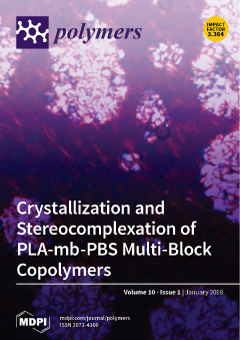Open AccessArticle
Gellan Gum/Pectin Beads Are Safe and Efficient for the Targeted Colonic Delivery of Resveratrol
by
Fabíola Garavello Prezotti 1, Fernanda Isadora Boni 1, Natália Noronha Ferreira 1, Daniella De Souza e Silva 2, Sérgio Paulo Campana-Filho 2, Andreia Almeida 3,4,5, Teófilo Vasconcelos 3,4, Maria Palmira Daflon Gremião 1, Beatriz Stringhetti Ferreira Cury 1 and Bruno Sarmento 3,4,5,6,*
1
Faculdade de Ciências Farmacêuticas, Universidade Estadual Paulista (UNESP), Araraquara, Rodovia Araraquara–Jaú, Km 1, Araraquara 14801-902, Brazil
2
Instituto de Química de São Carlos, Universidade de São Paulo (USP), Avenida Trabalhador São-Carlense, 400, São Carlos 13560-970, Brazil
3
I3S-Instituto de Investigação e Inovação em Saúde, Universidade do Porto, Rua Alfredo Allen, 208, 4200-135 Porto, Portugal
4
INEB-Instituto de Engenharia Biomédica, Universidade do Porto, Rua Alfredo Allen, 208, 4200-135 Porto, Portugal
5
CESPU-Instituto de Investigação e Formação Avançada em Ciências e Tecnologias da Saúde, Rua Central de Gandra 1317, 4585-116 Gandra, Portugal
6
School of Pharmacy, Queen’s University Belfast, Medical Biology Centre, 97 Lisburn Road, Belfast BT9 7BL, UK
Cited by 59 | Viewed by 6044
Abstract
This work addresses the establishment and characterization of gellan gum:pectin (GG:P) biodegradable mucoadhesive beads intended for the colon-targeted delivery of resveratrol (RES). The impact of the polymer carrier system on the cytotoxicity and permeability of RES was evaluated. Beads of circular shape (circularity
[...] Read more.
This work addresses the establishment and characterization of gellan gum:pectin (GG:P) biodegradable mucoadhesive beads intended for the colon-targeted delivery of resveratrol (RES). The impact of the polymer carrier system on the cytotoxicity and permeability of RES was evaluated. Beads of circular shape (circularity index of 0.81) with an average diameter of 914 μm, Span index of 0.29, and RES entrapment efficiency of 76% were developed. In vitro drug release demonstrated that beads were able to reduce release rates in gastric media and control release for up to 48 h at an intestinal pH of 6.8. Weibull’s model correlated better with release data and
b parameter (0.79) indicated that the release process was driven by a combination of Fickian diffusion and Case II transport, indicating that both diffusion and swelling/polymer chains relaxation are processes that contribute equally to control drug release rates. Beads and isolated polymers were observed to be safe for Caco-2 and HT29-MTX intestinal cell lines. RES encapsulation into the beads allowed for an expressive reduction of drug permeation in an in vitro triple intestinal model. This feature, associated with low RES release rates in acidic media, can favor targeted drug delivery from the beads in the colon, a promising behavior to improve the local activity of RES.
Full article
►▼
Show Figures






